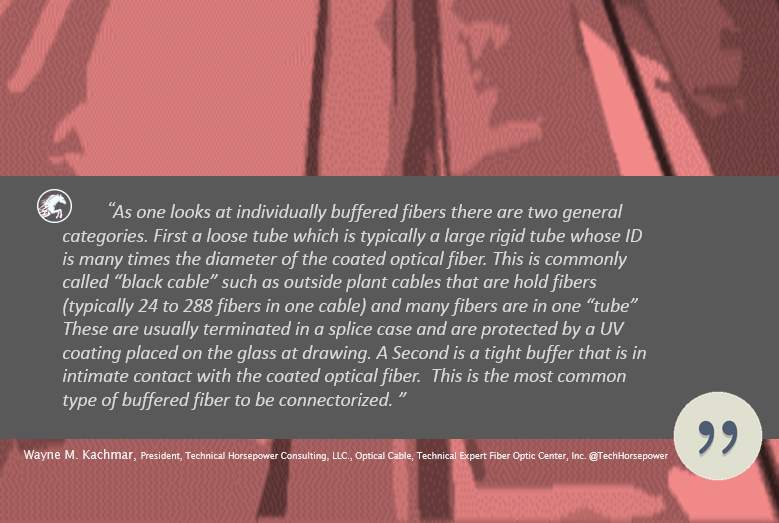One of the questions that I’ve been asked about many times is; how tight is the buffer on the cable that I am providing? Is it a “true tight buffer” or is it “semi-tight” or “loose tight buffer” or one of the other various terms thrown around such as tight bound, tight strippable, bonded, or even tension centered. etc. The biggest single concerns are in how the fiber will react in termination processing either for connectorization, preparation for fusion splicing, mechanical splices or sealing into an enclosure or furcation tube.
The reason for all of the concerns about how tight the buffer is placed on the fiber deal with whether or not there is enough gap or separation to allow independently removing the buffer from the coating or preventing the coating and buffer interstitial space from absorbing epoxy from connectorization or other termination operations.
As one looks at individually buffered fibers there are two general categories.
- First a loose tube which is typically a large rigid tube whose ID is many times the diameter of the coated optical fiber. This is commonly called “black cable” such as outside plant cables that are hold fibers (typically 24 to 288 fibers in one cable) and many fibers are in one “tube” These are usually terminated in a splice case and are protected by a UV coating placed on the glass at drawing.
- Second is a tight buffer that is in intimate contact with the coated optical fiber. This is the most common type of buffered fiber to be connectorized. There are many different ways to terminate an optical fiber that is tight buffered.
Several are most common, the most popular is the epoxy-based connector that is polished in a ferrule, in addition, there are a number of field-installable connectors that mechanically hold a fiber and mate the cleaved end to a fiber stub. Also, there are many types of mechanical splices that can be used to make either a permanent or temporary connection (such as for testing), and in many cases, fiber is pigtailed into a furcation tube to separate and protect it after being separated from a common jacket such as in indoor distribution cable. In that case, where each fiber is buffered with a polymer coating to 900um and stranded within a common protective jacket is now routed within a protective sheath with reinforcing members. In each of these termination methods, the relationship of the coating of the fiber and the buffer is different.

In our first case, an epoxy-based connector needs a tight buffer that will not wick epoxy between the coating and the buffer material. In this fashion where true tight buffers are mechanically in intimate contact with the coating of the fiber and are not applied in a way that could draw the coating away from the glass core and cladding. There can be no small spaces that could allow the epoxy to wick into the buffer or between the coating and the glass.
Many mechanical field terminable connectors use the 250 or 245 µm coding to restrain a cleaved fiber inside the back of the shell of the connector, therefore if you have a 900 µm tight buffer you have a need to strip the 900um buffer from The 245um UV coating. Typically the amount of distance is about a centimeter. In many cases, this need is called a semi-tight buffer. The actual need is a tight buffer that has a slightly less mechanical grip on the coating but is still not loose on the coating. If there is too much interstitial space the connector design may cause not enough force to be exerted on the actual optical fiber and after termination following all the connector manufacturer’s recommendations the fiber may move in the connector thus causing high loss. The hardness of the buffer material also can play a role in this problem.
In the third type of termination, when you are using a fusion splicer or coiling fiber ends in a pigtail mechanical splice you may need to remove 10 or more centimeters of buffer material while leaving the 245 µm coating material undamaged by the stripping process. Typically, this is referred to as a loose tight buffer. This is a common type of buffer when one end of a cable is connectorized at the factory and the other end is field terminated either with a fusion splice or a mechanical splice. In these cases the optical fiber is usually contained in a small splice tray and space for coiled fiber is limited. The fusion splicers usually can accommodate both 900um and 245 um coatings but many end-users prefer only one type of splice splint to be used. Also, there is limited space in the splice tray and coiling 2 meters of 900um fiber takes much more room than the same length of 245um fiber. When mixing epoxy type terminations and field splice terminations one of the concerns is that using a loose tight buffer in an Epoxy connector can cause wicking of the epoxy back into the cable end many centimeters which will likely cause a fiber break near the connector backshell.
Conclusion
While this is only a general description of how tight, semi-tight and loose tight definitions apply to buffered fibers in cables, hopefully, it helps to define the range of tightness and strip ability of buffers and optical cables. It is best to consider a specific strip test requirement when purchasing ”tight buffer” type cables based upon how and where you are using them. There are many more definitions than standards on tight buffer strip ability. So this may yet be the subject of a future IWCS paper as optical cable standards struggle to keep up with the technology changes in the industry.



